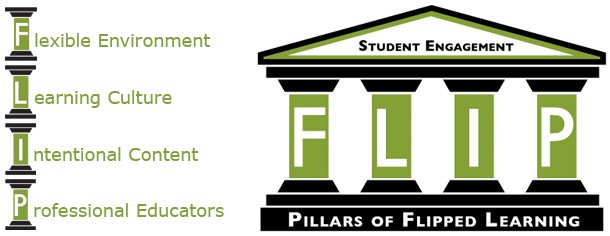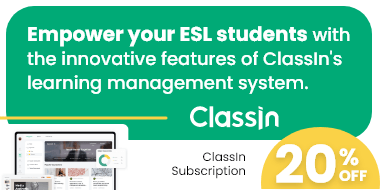Although the flipped classroom approach has been around for a long time, it has grown in popularity in recent years as technology has advanced, fast becoming a common classroom tool for instruction and study. The Flipped Classroom or Inverted Classroom approach, first introduced by Jonathan Bergmann and Aaron Sams with the acronym FLIP, which stands for Flexible Environments, Learning Culture, Intentional Content, and Professional Educators, combines synchronous (in-class) and asynchronous (outside-of-class) elements.
While you may be familiar with the flipped classroom approach in general education – university instructors have been practicing the method for years, assigning students materials to prepare for class discussion ahead of time – there are many reasons to consider the approach in ESL instruction as well. Let’s break down what is special about a flipped classroom, and why ESL teachers should consider applying the method to their own teaching environments.
Learn about five popular ESL teaching methods every teacher should know.
What is a flipped classroom?
In a flipped classroom, instructors assign students material to work on before coming to class. Additionally, in the classic flipped classroom model, teachers will record their lectures and make them available to students ahead of time. Thus, instead of using class time to lecture on a specific topic, that time is reclaimed to discuss, analyze, and practice what students have read or viewed. In the ESL class, teachers can record English grammar lessons or assign readings and vocabulary. Since, during a lecture, learners are essentially passive recipients of information, they don’t need the presence of the teacher or their peers. They can benefit from meeting the material directly and independently and processing it on their own time.

Some experts reject the inclusion of study material such as readings in the flipped classroom definition. However, as we shall see, the flipped classroom model can and should accommodate a variety of materials as long as they constitute preliminary knowledge and can prepare students for the intended class activities.
Learn how to make your ESL grammar lesson activities interesting, interactive, and inclusive.
Principles of a flipped classroom
The single most important principle of the flipped classroom approach is that the classroom is where active learning should happen. The flipped classroom is student-centered and is based on several pedagogical approaches.
- Learning styles theory posits that individuals learn differently. Adopting a teaching methodology that fits their teaching style can improve their learning. By freeing time for in-class activities, the flipped classroom enables teachers to better attend to individual students’ needs.
- Peer tutoring and collaborative learning is the idea that students can learn from and with each other. These practices have proven effective in enhancing students learning outcomes and social skills.
- Cooperative learning can be considered part of collaborative learning. In cooperative learning, “1) students work in teams toward the attainment of some superordinate goal, 2) labor is divided between team members, such that each individual takes responsibility for a different sub-goal, and 3) individual contributions are pooled into a composite product to ensure that the goal is reached.”
- Problem-based learning (PBL) – students can learn effectively by solving a pre-set challenge individually or in groups. Problem-solving promotes higher-order thinking skills like creativity and critical thinking.
- Active learning is any learning process that requires the learner’s active participation as an individual or as a member of a team. Active learning has become almost synonymous with the flipped classroom approach because, without it, the flipped classroom simply cannot exist.
What are the four pillars of the flipped classroom?
There are four pillars that support the flipped classroom model. As exemplified by the acronym FLIP, these are:
- Flexible Environments – A flipped classroom necessitates a flexible learning space. Flexibility here refers to both a rearrangement of the physical space to accommodate pair or team activities and flexibility on the part of the teacher in determining what should be taught in and out of class and modifying the initial goals according to students’ needs.
- Learning Culture – The Flipped Classroom requires a move from a teacher-centered to a student-centered teaching and learning culture. For the students, this means taking on an active role in their learning by doing the out-of-class preliminary work and actively participating in in-class activities. For the teacher, it means taking on more the role of a facilitator than of an instructor.
- Intentional Content – Teachers must carefully consider what parts of their class they want to flip. What part of the content can students deal with independently? Which activities should be carried out with peers, and which necessitate the teacher’s presence? Much of the grammar instruction and vocabulary learning in the ESL class can be taught through digital tools, leaving class time for practicing the structures and vocabulary learned.
- Professional Educators – Flipped learning is student-centered, but that doesn’t mean the teacher takes a back seat. Teachers must carefully monitor students’ activities, provide feedback, and assess students’ work. They must be instantly aware of which students need additional support and devise ways to provide it. Thus, professional educators are essential to the implementation of the flipped classroom.

What are the benefits of flipped learning?
The ESL flipped classroom model has several advantages for both students and teachers, including the following:
- It turns students from passive receivers into active learners.
- It allows students to learn at their own pace. Students have access to recorded grammar explanations that they can rewind at any time or can practice vocabulary on their own time using a digital platform.
- It may be especially suitable for students who don’t perform well in a traditional class environment. For example, students reluctant to speak in the TL in front of the whole class may do better with a peer or in a small group.
- By creating time for practice, it improves fluency.
- It promotes higher-order thinking. Once learners have acquired the necessary background knowledge, they can apply that knowledge, analyze and discuss content, and create original output.
- It promotes students’ independence and self-sufficiency. Students are encouraged to take responsibility for their own learning.
- It fosters other extra-linguistic skills like the ability to work in teams and to communicate and organize.
When would an ESL teacher use a flipped classroom?
The main reason why ESL teachers should try out the flipped classroom model is that, by focusing on in-class activities, this approach automatically fosters fluency. While the flipped classroom approach can be adopted in any learning environment, it is especially useful when teachers have limited contact time. The flipped classroom can help them get the most from the contact hours by turning them into practice time. Other reasons for adopting the flipped classroom model are that it enables teachers to work closely with students, focus on individual students who may need additional support, increase students’ participation, and, as a byproduct, improve fluency.
Let’s now look at some examples of the ESL flipped classroom.
What are some examples of ESL flipped learning?
So, what does ESL flipped learning look like? When considering an ESL flipped classroom, the first question we should ask is, what part of an ESL class can be flipped? In other words, what aspects of the language can learners take on independently? While the answers will vary depending on individual students, there are some parts of the language instruction that teachers can safely assign as out-of-class, preliminary work.
What the research says
Researcher Jay Andress, author of Flipped Classroom – Principles of Teaching and Learning, points out that an ideal language course consists of “1) meaning-focused listening and reading, 2) Language-focused instruction, 3) meaning-focused speaking and writing, and 4) fluency development activities.” In other words, meaning-focused input can be provided out of class, and meaning-focused output is the object of in-class activities. Meaning-focused input can be provided in the form of:
- Vocabulary study – this can be delivered through language-learning platforms like Duolingo, Quizlet, and numerous others.
- Grammar instruction with a lot of examples. For grammar instruction, the teacher may choose to record an instructional video or use one of the many available online.
- Videos in the target language to be discussed and analyzed in class. Short videos can be used as a stepping stone for in-class conversation. For example, videos on any aspect of culture in English-speaking countries as illustrations or inspiration for roleplay. Others can be used simply to assess students’ understanding of specific topics/lexical areas.
- Readings – although not traditionally part of the flipped classroom, guided readings with unknown vocabulary can be used much like videos. This is intended to give students “meaning-focused input” and as a preliminary to in-class activities.
Learn about 12 fun ESL reading comprehension activities for all levels.
Practical application according to teaching style
All the above is preparatory for the activities unfolding in class and provides opportunities for meaning-focused output. For example, students may be assigned a vocabulary list on job interviews or watch a video of a job interview. Next, they will be prompted to discuss the hiring process in English. Additional practice could include role-play in pairs as interviewer and interviewee.
Lastly, ESL teachers who prefer a more active, student-centered teaching style should explore the flipped classroom approach. This is especially true for teachers who feel pressed for time. Students should have sufficient opportunity to practice what the lesson covered after each class. If your classes are lacking this time, the flipped classroom might be for you. It is often an effective and practical solution to improve student learning outcomes.





